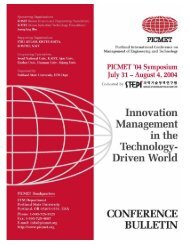Technology & Innovation Management: - PICMET Conference
Technology & Innovation Management: - PICMET Conference
Technology & Innovation Management: - PICMET Conference
Create successful ePaper yourself
Turn your PDF publications into a flip-book with our unique Google optimized e-Paper software.
PAPERS AND PANELS<br />
Japan - New Styles of <strong>Management</strong><br />
Tomomichi Yoshikawa, Yokohama City University<br />
In Japan, especially after the 1990s, a large number of R&D-based<br />
small venture firms were established. This relatively new phenomena<br />
indicates that the new type of firm is quite different from traditional<br />
SMEs. Some of them do not produce their product; rather,<br />
they are developing a new product based on product technology. On<br />
the contrary, traditional small and medium enterprises (SMEs) are<br />
well known as competitive parts suppliers to assembly makers based<br />
on process technology. We have interviewed more than 40 R&D<br />
based venture firms, analyzed their characterizations in terms of<br />
technology, market, marketability, product differentiation, product<br />
life, increasing return and innovation process.<br />
MB-11.4 - Financing of Innovative <strong>Technology</strong> Based Ventures:<br />
Study in Indian Context<br />
Vimal Kumar, Government of India<br />
P.K. Jain, Indian Institute of <strong>Technology</strong><br />
At the present stage of globalisation of the Indian economy, it is<br />
being further realised that innovative technology-based ventures are<br />
imperative. Ever-increasing competitiveness in the technological<br />
arena around the globe on the one hand and the requirement of lowcost<br />
funds for such ventures on the other hand have made the subject<br />
a matter of serious concern to policy makers. The paper presents<br />
the financing of innovative technology-based ventures in the Indian<br />
context. The study is based on a stratified sample covering all major<br />
stake holder segments. It reveals that the funding mechanisms, interalia,<br />
are beset with higher interest rates & lack of long-term vision.<br />
MB-12 Monday, July 26, 1999<br />
10:00 - 11:30 Senate<br />
Supply Chain <strong>Management</strong> - 1<br />
Chair: David J Sherwin, Vaxjo University<br />
MB-12.1 - A Distributed GDSS for Supply Chain <strong>Management</strong><br />
Zice Song, Nanyang Technological University<br />
Robert de Souza, Nanyang Technological University<br />
Chaoyang Liu, Nanyang Technological University<br />
In this paper, the authors propose a novel framework for implementing<br />
the distributed group decision support system for supply chain<br />
management. It enables the decision-maker to have both what-if and<br />
what-best scenarios. Market mechanism, especially the price system,<br />
is applied as the coordination mechanism of the group optimization<br />
to obtain Pareto optimal solutions.<br />
MB-12.2 - Buyer-Seller Relationships in the Supply Chain: Factors<br />
Affecting Customer and Seller Commitment<br />
Chickery Kasouf, Worcester Polytechnic Institute<br />
Kevin Celuch, Illinois State University<br />
Samukta Warty, Worcester Polytechnic Institute<br />
Original equipment manufacturers (OEMs) need to develop a supply<br />
chain that is willing to invest in product development, yet sellers are<br />
often skeptical of the buyer’s commitment and thus apprehensive<br />
about making investments in project specific assets. This paper proposes<br />
a bilateral model to explain buyer-seller relationships.<br />
MB-12.3 - Modularization in NPD and Supplier-Buyer Partnerships:<br />
A Mathematical Modeling Approach<br />
Juliana Hsuan, Copenhagen Business School<br />
Modularization facilitates supply chain management as it substantially<br />
reduces and standardizes manufacturing processes, subsequently altering<br />
the nature of firms’ supplier-buyer partnerships. The mathematical<br />
model analyzes the opportunities for modularization with respect to<br />
interface constraints at component, module, sub-system, and system<br />
levels, and how it is influenced by supplier-buyer partnerships.<br />
MB-13 Monday, July 26, 1999<br />
10:00 - 11:30 Pavilion East<br />
Industry Applications-1: Utility Industry<br />
Chair: Janice L Forrester, Cytera Systems, Inc.<br />
MB-13.1 - Managing Information <strong>Technology</strong> for Improving Service<br />
Quality in the Electric Utility Industry<br />
Pratyush Bharati, Rensselaer Polytechnic Institute<br />
Daniel Berg, Rensselaer Polytechnic Institute<br />
Service quality has become increasingly important. Information<br />
<strong>Technology</strong> (IT) is integral to a service organization. The challenge is<br />
to manage IT to enhance service quality. Concepts from management<br />
information systems, communications and strategy have integrated<br />
in a conceptual model, which describes the management of IT to<br />
improve service quality. The model is backed by recent data.<br />
MB-13.2 - A Multi-Objective Economic Model to Assess and Evaluate<br />
Capital Expenditures Associated with a Foreign Utility<br />
Gregory Jones, Enron/ Portland General Operations Company<br />
Daniel Jones, Enron/Portland General Operations Company<br />
The privatization of the global energy market has presented unique<br />
problems and issues to the investor. With these unique problems and<br />
issues, the need arises for creative solutions when bringing innovative<br />
technology to a utility. The objective of the model presented<br />
herein is to assist the decision-maker in the assessment of the<br />
costs/benefits of implementing innovative technology programs into<br />
the financial performance of a utility.<br />
MB-13.3 - A System Approach Towards an Effective IT Strategy for<br />
Modern Electric Utilities<br />
Kam-Hoong Cheong, Royal Institute of <strong>Technology</strong><br />
Magnus Haglind, KTH<br />
An increasing number of electric utilities are attempting to formulate<br />
an effective information technology (IT) strategy to assist them in<br />
confronting the newly deregulated, rapidly changing business environment.<br />
Through a case study and a quantitative survey, this paper<br />
uncovers some of the weaknesses of existing IT strategy and proposes<br />
a system approach towards achieving a more effective IT strategy.<br />
MB-13.4 - Time Wars: Is There a Declining Financial Justification for<br />
Rapid Technical Advance in the Telecommunications Industry?<br />
Donald Hicks, University of Texas at Dallas<br />
Seeking to use rapid technical advance to establish their competitiveness,<br />
telecom equipment manufacturers and services providers must<br />
face questions about whether massive internal R&D investment remains<br />
financially justified. Supplementing identity-preserving innovation<br />
strategies such as internal R&D investment and strategic (embodied<br />
R&D) procurement, more spontaneous identity-transforming producer<br />
alliances have surged as an alternative route to rapid technical advance.<br />
MC-02 Monday, July 26, 1999<br />
13:30 - 15:00 Galleria-2<br />
<strong>Technology</strong> Marketing 2<br />
Chair: Robert Harmon, Portland State University<br />
MC-02.1 - Channel Strategy in the Data Projector Industry<br />
Candace Petersen, C. Petersen Consulting<br />
Robert Harmon, Portland State University<br />
33










